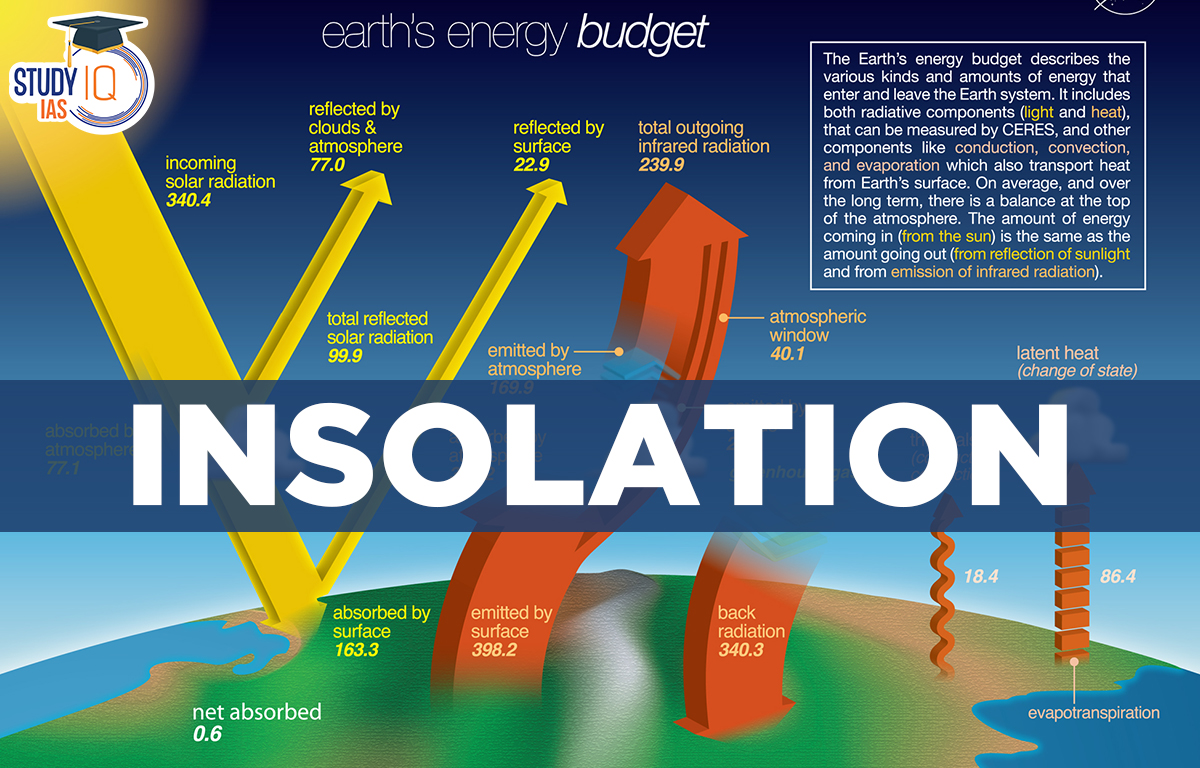Table of Contents
Insolation
Insolation is the sunlight that reaches the Earth. It comes in short waves from the sun. Because the Earth is small and not very far from the sun, it gets a very tiny amount of this sunlight. Only two billionths of a percent of the sun’s total energy reaches the Earth’s surface, which means just two units of energy out of 100 million. This small amount is very important because it provides most of the energy required for life and many processes on our planet. Some sunlight is also absorbed by dust, ozone, water vapor, and other gases in the atmosphere.
Read More: Isotherms
Insolation Factors Effecting
Solar insolation, or sunlight, is not the same everywhere on Earth. Several factors determine how much sunlight different places get. One important measure is the solar constant, which tells us how much solar energy reaches the top of the atmosphere. The main factors that affect insolation include changes in the land’s shape, like mountains and valleys. Differences in elevation, the angle of the ground, and nearby hills or buildings can create strong local differences in sunlight. The solar constant is about 1370 Watts per square meter at the thermopause, the boundary between two layers of the atmosphere. This value can change slightly due to sunspots, which are dark spots on the sun that can impact its energy output.
Angle of Incidence
The angle at which the Sun’s rays hit the Earth’s surface changes based on where you are. In higher latitudes (closer to the poles), the angle is smaller, which means less sunlight reaches the ground. This is one reason why the equator is warmer than the poles.
Duration of the Day
The length of the day also affects how much sunlight reaches the Earth. The longer the day, the more sunlight there is. At the equator, days are always about 12 hours long, but as you move toward the poles, the difference between day and night gets bigger.
In the far north and south, there are two special events:
- Polar night: When it’s dark for more than 24 hours.
- Polar day (or midnight sun): When the Sun stays above the horizon for more than 24 hours.
Distance from the Sun
The Earth orbits the Sun in an oval shape. This shape changes slightly in a cycle that lasts about 100,000 years. When the Earth’s orbit is more circular, it gets 23% more sunlight than when it is more elongated.
Read More: Heat Transfer
Gradients of Insolation
Local differences in sunlight happen because of things like height, the angle of the land, and nearby hills blocking the sun. For example, in the northern hemisphere south-facing slopes get more sunlight and warm winds, making them warmer and drier than north-facing slopes.
In the Swiss Alps, farmers grow more crops on south-facing slopes. In the Himalayas, south-facing slopes are warm, wet, and have forests, while north-facing slopes are cold, dry, and often covered in ice. On hills with some sunlight, you can see more plants and people.
Perihelion and Aphelion
| Perihelion | Aphelion |
|
|
Read More: Heat Waves
Axial Tilt of the Earth
The Earth rotates around its axis and makes an angle of 66½ with the plane of its orbit around the sun. This particular characteristic of the Earth has a significant amount of influence on the amount of insolation received at different latitudes. The seasonal changes that are seen in both hemispheres are the result of the axial tilt of the Earth and not because of the closeness of the Earth to the Sun. As the earth is round, the sun’s rays strike the surface at different angles as the earth is round. The angle formed by the sun’s rays with the tangent of the earth’s circle at a point is called the angle of incidence. It influences the insolation in two ways as follows:
- When the sun is almost overhead, the sun’s rays are vertical. Here the angle of incidence is large. Hence, they are localized in a smaller area and give more insolation at that place. If the sun’s rays are oblique, the angle of incidence is small and thus sun’s rays have to heat up a greater area and thus result in less insolation received there.
- The angle of inclination of solar radiation from the Sun depends on the latitude of a place. The higher the latitude is, the lesser angles they make with the Earth’s surface, resulting in slanting sun rays. The sun’s rays with small-angle travel more of the atmosphere than rays striking at a larger angle. The longer the path of the Sun’s rays, the amount of reflection and heat absorption by the atmosphere is greater.
Read More: Weathering
Insolation in Summer and Winter Seasons
The length of the day depends on where you are (latitude) and the season. The amount of sunlight (insolation) is connected to how long the day is because sunlight only comes during the day. When days are longer, there is more sunlight. In summer, the days are longer, so we get more sunlight. In winter, the days are shorter, so we get less sunlight.
Read More: Physical Weathering
Insolation and Temperature on Earth
On account of the earth’s inclination on its axis at an angle of 23 ½ degrees, rotation and revolution, the day’s duration is not the same everywhere on the earth. At the equator, there are 12 hours day and night throughout the year. As one moves towards the poles, the days keep on increasing or decreasing. This explains why equatorial regions receive the most solar radiation.
The Earth’s atmosphere is nearly transparent to shortwave solar radiation that passes through the atmosphere before striking the earth’s surface. The transparency depends upon cloud cover, its thickness, water vapour and solid particles as they reflect, absorb or transmit insolation. The Ozone Layer absorbs high-energy ultraviolet rays. Thick clouds hinder the insolation from reaching the earth, while a clear sky helps it reach the surface.
Water vapour absorbs insolation, resulting in less insolation reaching the surface. The troposphere’s extremely small suspended particles disperse the visible spectrum both toward space and the earth’s surface.
Read More: Structure of the Atmosphere
Insolation Solar Variation
Solar Variation: Solar variation means changes in the amount of radiation the Sun gives off. One main change is the 11-year sunspot cycle, where dark spots appear on the Sun’s surface. More sunspots mean slightly more solar radiation, but the difference is very small.
The amount of sunlight received varies, with about 320 Watts/m² in the tropics and around 70 Watts/m² at the poles. Subtropical deserts get the most sunlight, while the Equator gets less because of clouds. Land areas receive more sunlight than oceans at the same latitude because clouds over oceans reflect sunlight away.
Isohels: Isohels are lines on a map that connect places receiving the same amount of sunshine. They are mostly parallel to lines of latitude, especially in the southern hemisphere.
Read More: Chemical Weathering
Insolation UPSC
The amount of solar energy that the planet receives or absorbs is known as insolation. Through volcanoes, springs, and geysers, some of the heat in the core and mantle is transmitted to the surface and the bottoms of the oceans. However, the amount of heat that the earth’s surface receives from its interiors pales in comparison to the heat that comes from the sun.
A crucial component of your UPSC preparation is geography. Both the UPSC Prelims and Mains General Studies Paper I include it. You may study everything about sun radiation, heat balance, and temperature for the IAS Exam in this post.


 Story of Meera Bai and Her Devotion For ...
Story of Meera Bai and Her Devotion For ...
 Desert Climate, Distribution, Climatic C...
Desert Climate, Distribution, Climatic C...
 Deserts of India Map, Features of Thar D...
Deserts of India Map, Features of Thar D...





















